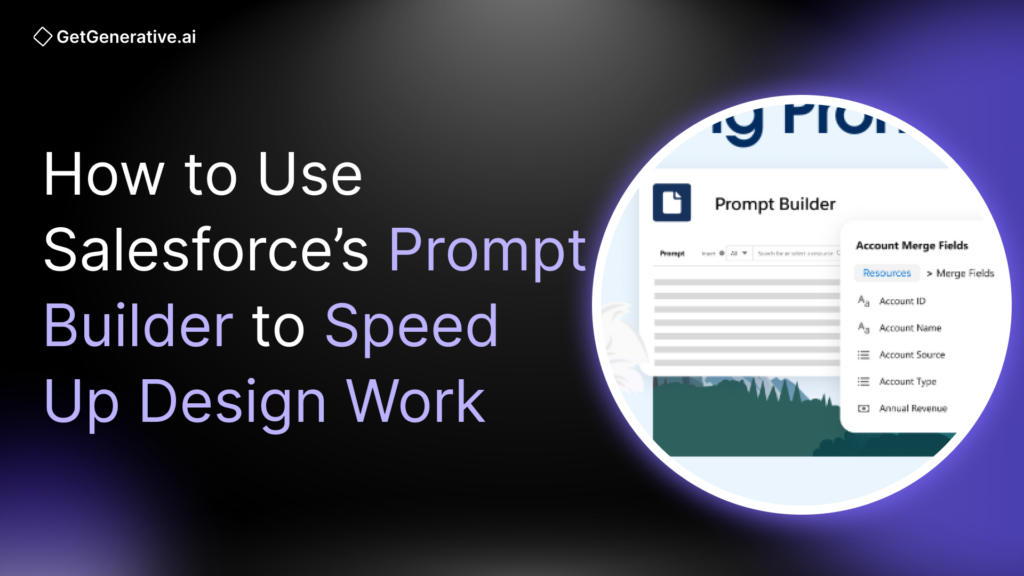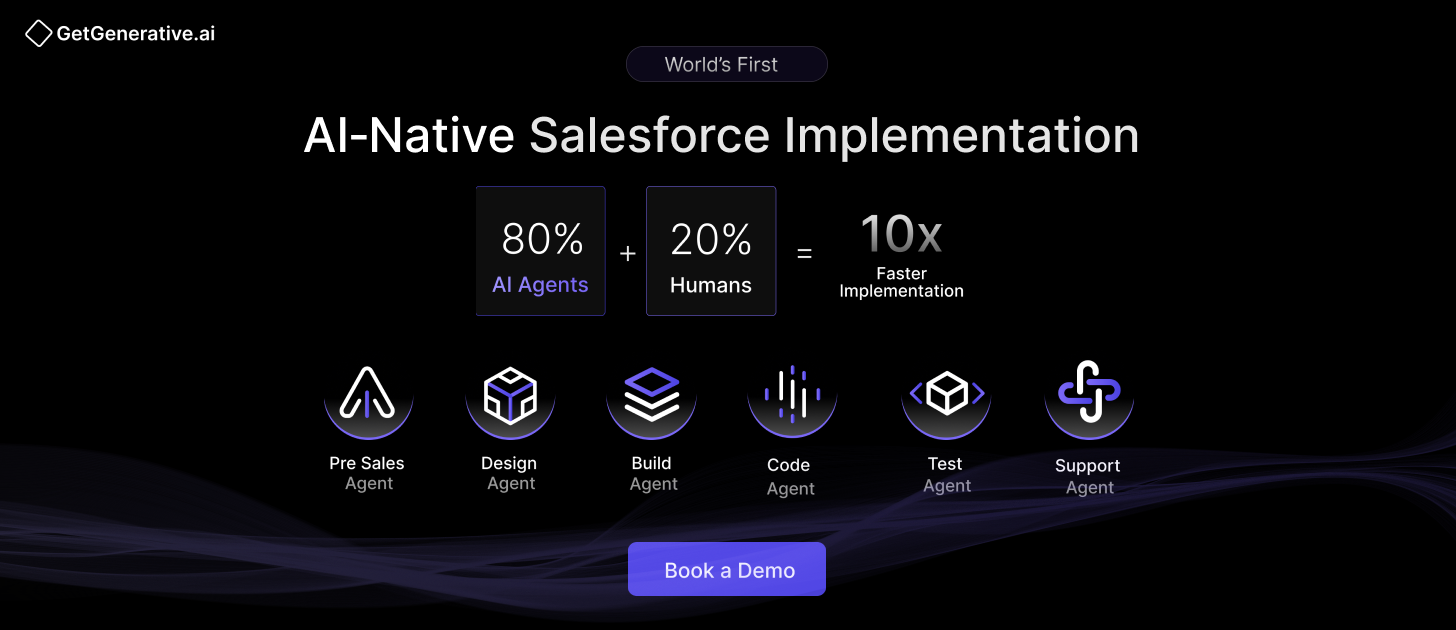How to Use Salesforce’s Prompt Builder to Speed Up Design Work
Salesforce’s Prompt Builder, part of the Einstein 1 platform, exemplifies this shift. It empowers admins and designers to embed reusable, AI-powered prompts directly into CRM workflows, reducing manual content creation and dramatically speeding up design work.
With up to 90% productivity gains reported for AI-supported tasks and 93% of marketers using AI to generate content faster, Prompt Builder transforms routine tasks like email drafting, record summarization, and narrative content generation into one-click actions—all while keeping data safe within Salesforce’s secure environment.
What Is Salesforce Prompt Builder?
Prompt Builder is a no-code prompt engineering tool built directly into the Einstein 1 platform. Unlike generic AI chat interfaces, Prompt Builder is tightly integrated with Salesforce data and workflows. It lets admins build reusable AI prompt templates that:
- Use merge fields from CRM records
- Pull context from Data Cloud or external systems
- Operate within Salesforce’s Einstein Trust Layer
Key Capabilities at a Glance
- No-Code Templates: Write prompts like “Draft a follow-up email for {Lead.Name}…” with click-to-activate templates
- Data Grounding: Merge real-time CRM values into prompts for factual, personalized outputs.
- Einstein Trust Layer: Protect sensitive data through encryption and masking before interacting with LLMs.
- Workflow Integration: Embed prompts into record pages, Flows, Copilot sidebars, or Agentforce actions.
In short, Prompt Builder enables Salesforce admins to act as in-house prompt engineers, creating safe, scalable, and structured AI experiences that are embedded directly into day-to-day design workflows.
How Prompt Builder Accelerates Design Workflows
Prompt Builder accelerates content design by automating time-consuming tasks such as writing, formatting, and summarizing—without compromising control or compliance.
1. Reusable Templates with Guardrails
Admins can create prompt templates using structured instructions and conditional logic. For example, a “Deal Summary” prompt might include:
- Sections like Summary, Contacts, Risks, and Next Steps—only if relevant data exists
- HTML formatting rules or bold headings
- Guardrails to exclude empty fields or avoid filler phrases
This ensures consistent, high-quality output—without requiring each user to write from scratch or worry about formatting.
2. Data-Driven Personalization
By merging live Salesforce fields into prompts, Prompt Builder enables the creation of hyper-personalized content. For example:
A prompt like “Send a follow-up email to {Lead.Name} about {Product.Name}” generates a custom email for every lead, complete with dynamic subject lines and tone-of-voice instructions.
This eliminates repetitive personalization work for reps and content creators.
3. Embedded in the UI
Prompt Builder integrates tightly into the Salesforce experience. You can:
- Place buttons on record pages to generate summaries or emails
- Use Lightning App Builder or Flows to fetch data and trigger prompts
- Embed prompts into Slack, Copilot, or mobile apps for contextual access
For example, admins have created a “Summarize Open Cases” button on the Account page that generates a paragraph summarizing all open issues—ready for review with a single click.
4. One-Click Output and Iteration
Prompt templates offer instant results. Users trigger them manually or via Flow, preview the output, and edit if needed. Admins can:
- Test prompts with sample data in Preview mode
- Tweak instructions, tone, and structure
- Apply updates globally across workflows
This shortens iteration cycles and guarantees accurate AI output—without code.
Also Read – Prompt Engineering for Salesforce Developers
Common Use Cases for Designers and Admins
Prompt Builder’s design impact is most visible in high-volume, repetitive tasks. Key examples include:
1. Email & Document Drafting
Designing marketing or sales emails? Prompt Builder can handle:
- Outreach, confirmation, or follow-up emails
- Personalization using CRM fields
- Tone control (“Avoid clichés like ‘hope this finds you well’”)
- CTA structuring and formatting rules
A single prompt template can replace dozens of manually written emails per day.
2. Dynamic Content Generation
Prompt Builder’s Field Generation templates convert structured data into polished narratives:
- Retailers: Auto-generate product descriptions from SKUs
- Support teams: Summarize open cases with issue counts and key terms
- Sales: Turn opportunity fields into formatted deal reports
One click replaces hours of writing.
3. Record Summaries & Reports
Need exec-level summaries? Prompt Builder can:
- Output HTML-rich record summaries
- Exclude null or empty values
- Add links, format dates/currency, and structure content for easy reading
Example: A “Lead Summary” includes key info, status, and activities in a neatly formatted block embedded into Lightning pages or PDF exports.
4. Marketing & Creative Work
Prompt Builder supports brainstorming and creative content:
- Generate campaign taglines, landing page copy, or blog intros
- Output draft versions for A/B testing or stakeholder review
- Power content templates for Journey Builder personalization
This frees marketing and design teams to focus on strategy, not filler text.
Also Read – The Ultimate Salesforce Prompt Builder Cheat Sheet
Best Practices: Designing Effective Prompts That Scale
To fully realize the benefits of Prompt Builder, organizations should apply prompt engineering best practices that maximize accuracy, consistency, and ROI.
1. Start with Clear Objectives
Every prompt should serve a measurable purpose. Ask:
- What task are we automating?
- What does ideal output look like?
- What’s the KPI—time saved, output quality, user adoption?
Example: Instead of “Write a sales email,” use:
“You are a sales engineer writing to {Lead.Name} to follow up on {Product.Name}. Keep tone professional, CTA at the end, max 100 words.”
This clarity enables better design outcomes and meaningful performance tracking.
2. Use Role–Task–Format Structure
This 3-part structure improves prompt reliability and comprehension for the LLM:
- Role: “You are a support agent…”
- Task: “…summarizing open cases…”
- Format: “…in a paragraph under 150 words, plain language, no bullets.”
Including example inputs and outputs (few-shot prompting) or step-by-step logic (chain-of-thought) can dramatically improve results, especially for decision-making prompts.
3. Leverage Merge Fields and Flow Variables
To make prompts data-grounded, include tokens like {!Opportunity.Stage} or variables from Flows. This ensures personalization and factual accuracy.
As Gearset notes:
“Grounding the prompt in your Salesforce data is key to getting the most relevant, personalized responses.”
When prompts require aggregated data (like open case summaries), Flows can fetch and pass the necessary context into the template.
4. Define Guardrails Clearly
Avoid hallucinations by explicitly telling the AI how to behave with missing or incomplete data:
- “Do not include empty fields”
- “If ‘Next Step’ is unavailable, omit that section”
- “Stick to US English; no Markdown formatting”
These constraints ensure clean, predictable output and reduce error handling overhead.
5. Iterate Prompt Designs with Testing
Use Prompt Builder’s Preview mode to:
- Test with real data
- Review edge cases
- Refine tone, structure, and word choice
As Salesforce recommends, templates should be:
“Tested, revised, customized before going live.”
Regularly iterate based on user feedback, evolving business needs, or updated regulations.
6. Track Usage and Outcomes
Use reporting tools and Agentforce analytics to answer:
- Are users adopting the prompt?
- How much time is it saving?
- What’s the acceptance rate of AI-generated content?
Example: For a “Case Summary” prompt, measure how often agents accept vs. edit the AI output.
These metrics inform prompt refinement and help justify continued investment.
7. Establish Governance and Ownership
Treat prompt templates like enterprise assets. That means:
- Version control (e.g., via DevOps Center or metadata APIs)
- Permission sets for creation and execution
- Change review and approval workflows
Train admins and designers in prompt engineering, and assign roles for ownership and iteration. For regulated industries, implement formal approval chains and audit logging.
Also Read – Getting Started with Code Builder and Agenforce in Salesforce
Security, Compliance, and Trust
Prompt Builder doesn’t just offer productivity—it’s designed for enterprise-grade trust and governance.
Data Security: The Einstein Trust Layer
Every prompt runs inside the Salesforce Trust Layer, which:
- Encrypts or masks sensitive data (like names, emails)
- Ensures LLMs never see raw PII
- Maintains compliance with frameworks like GDPR, HIPAA, and SOC 2
Accuracy and Bias Control
Generic LLMs risk hallucination. Prompt Builder mitigates this through:
- Contextual grounding with real CRM values
- Instructions like: “Only use the data provided”
- Fallbacks for missing data (e.g., “Say ‘unknown’ if empty”)
This structure significantly reduces factual errors and hallucinated output—top concerns for over 50% of users, according to Salesforce research.
Compliance and Oversight
Especially critical for regulated industries, Prompt Builder includes:
- Prompt Approval workflows
- Audit logs of AI interactions
- Role-based access control
- Compatibility with Salesforce Shield and Security Center
Templates can be deployed via change sets, unlocked packages, or DevOps pipelines, ensuring AI governance matches your software lifecycle.
Final Thoughts
Salesforce’s Prompt Builder marks a significant step in integrating AI into core enterprise design work. It doesn’t just speed things up—it enforces best practices, safeguards sensitive data, and enables scale with control.
At GetGenerative.ai, we’ve reimagined Salesforce implementation—built from the ground up with AI at the core. This isn’t legacy delivery with AI added on. It’s a faster, smarter, AI-native approach powered by our proprietary platform.
👉 Explore our Salesforce AI consulting services




